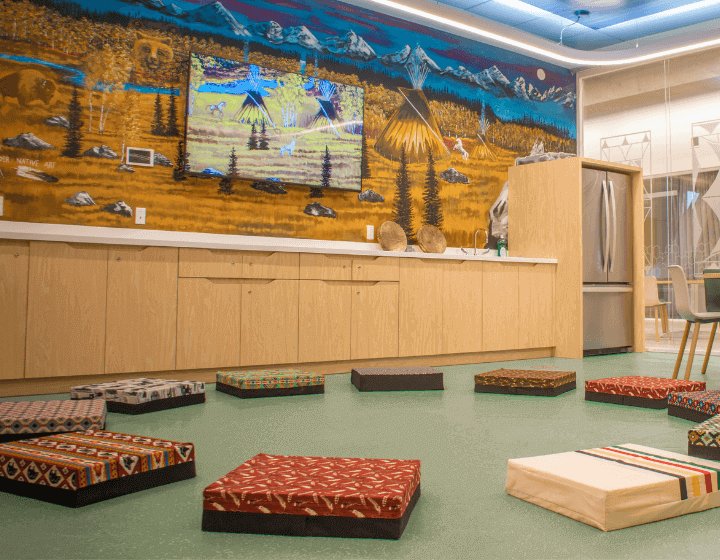Learn in advance.
Prior experience with a culture influences how engaged we are by its' stories. Learning about the storyteller and their culture often makes it easier for children to connect to the material.
Caretakers of the Land is a virtual program for grades K – 6. In this program, Elders, Knowledge Keepers, authors, illustrators, performers, and Library staff share the diverse perspectives and ways of knowing of First Nations, Métis and Inuit people living in Alberta.
Use the information, activities, booklists, and resources on this page at home or in class to support students as they learn about Indigenous ways of knowing.


For Indigenous people, the land is their mother, providing enough for people, animals, plants, the waters, and the land to live in harmony with each other. It is where their laws, values, and teachings come from.
Acknowledging the land reminds us that it is sacred to Indigenous peoples. It helps us build respectful relationships, and is an important part of reconciliation.
You can honour the land with this land acknowledgment written by the Library’s Indigenous Services team:
Today we acknowledge our Treaty 7 friends,
Where the Blackfoot meet on Elbow’s bend.
Soon came the Tsuut’ina from the Beaver clans,
And the Îethka Stoney Nakoda who live in mountain lands.
Last but not least, the Métis from Region three,
We are all treaty people, here in Calgary.
In Calgary, we are all treaty people. Our schools, libraries, and homes are on the ancestral territories of the Blackfoot people and home to Treaty 7 signatories of Southern Alberta.
These include the Blackfoot Confederacy (Siksikaitsitapi) – the Blackfoot First Nations, the Siksika, the Piikani, and the Kainai – the Stoney Nakoda First Nation bands of Chiniki, Bearspaw, and Wesley, the Tsuut'ina First Nation, and the people of Métis Region 3.
For more information on the Blackfoot language and help pronouncing the words, visit the Blackfoot Online Dictionary.
Our Land Acknowledgment resources have more tips for pronunciation.
Did you know “trickster” is a contemporary word anthropologists use to describe important beings in Indigenous cultures? The more appropriate name used in Blackfoot communities is “Spiritual Beings,” as these figures have immense spiritual power.
Trickster stories often teach lessons about how to behave and treat other people; they have been used to teach children for many centuries. Tricksters are smart and use their knowledge to play tricks or bend the rules. A trickster often appears as an animal with human traits — like being able to talk. Many trickster stories feature a coyote or raven because these creatures are clever, but tricksters can also be shapeshifters, moving easily between our world and the spirit world, and can appear as animals, humans, or even rocks!
"Napi is a Blackfoot character that is central to our stories. Often called the “Old Man,” Napi is the creator — along with “Old Woman” — of many of our objects and creatures. Napi is not our god, yet like many divine entities, he is credited with the creation of the world and everything in it.
But Napi also gets into a lot of trouble when he starts messing with his creation. This is why we refer to Napi as a trickster. His many stories help guide our lives, giving us insight into our human condition. While Napi stories are often told by Elders who have been the recipients of these stories from time immemorial, a new generation of Blackfoot artists, actors, and storytellers have created new Napi stories. Napi is not static, he is dynamic."
— Adrian Stimson, Blackfoot artist
Learn more about Napi with these titles, or check out these stories about Trickster gods from different cultures.
Indigenous cultures share stories in many ways — orally, in song, in drumming, through dance, with pictographs, and through medicine wheels and tipi rings. Traditionally, stories are told by Elders, or community members who have earned the ability and may be called a Storyteller, or Knowledge Keeper. Deep and active listening is required when listening to Indigenous stories.
Indigenous stories are different than western stories. They do not always have a clear beginning, middle, and end. Indigenous stories may affect your student’s emotions, thoughts, spirit, or body differently. Stories are meant to trigger reactions, invite reflection, awaken feelings, activate memories, and touch the heart. Allow students to be affected.

When Napi is warned not to jump too long on the ice, he quickly learns a lesson about the value of listening.
Mice are having a celebration that Napi and the dogs want to join. What could go wrong?
The story of a young Blackfoot boy, and the traditional meanings of his braided hair.
Blackfoot Language Resource Project from the University of Lethbridge contains audio recordings in Blackfoot, with transcripts, and others shared in English.
Blackfoot Teacher’s Guide developed by Elders Reg Crowshoe, Geoff Crow Eagle, and Maria Crowshoe provides learning activities for students in grades 1-6.
Empowering Spirit is a comprehensive collection of Alberta-based educational resources to support reconciliation.
Four Directions Teaching is an interactive site for students grades 5 and up, and covers teachings of the Piikani Blackfoot, Haudenosaunee/Mohawk, Ojibway/Anishinaabe, Woodlands Cree, and Mi’kmaq First Nations.
Guiding Voices is an Alberta Education curriculum tool for integrating First Nations, Métis, and Inuit perspectives through your curriculum.
National Centre for Collaboration shares information from an Indigenous perspective. It covers topics like biology, nutrition, history, and music.
Niitsitapiisini Teacher Toolkit from the Glenbow Museum accompanies their online exhibit about Blackfoot (Niitsitapiisini) culture.
Stepping Stones is a publication of the Alberta Teachers’ Association that supports teachers in learning to meet the First Nations, Métis, and Inuit Foundational Knowledge competency.
Ten Ideas to Learn More About Treaty 7 and Métis Culture like books, videos, and backyard adventures.
Traditional Stories are available to listen to through the Glenbow Museum. These audio recordings are spoken in Blackfoot, with English transcripts provided.
Werklund School of Education provides resources related to colonization, ways of life, literature, and decolonization.
Books to Build On: Indigenous Literatures for Learning is an interactive web resource that is designed to assist educators with weaving Indigenous ways of knowing, being, and doing into their teaching and learning.